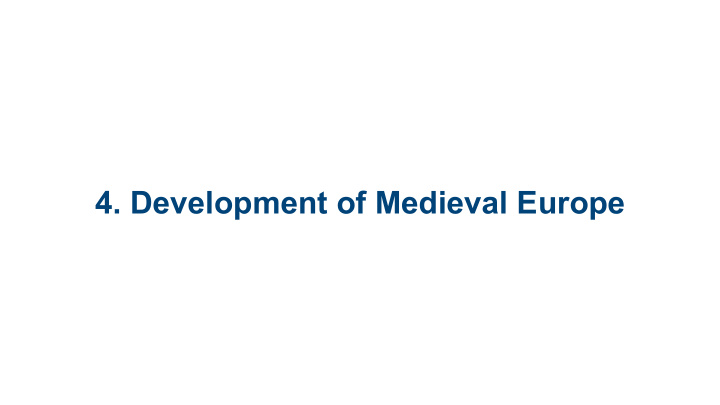



4. Development of Medieval Europe
4.1. Byzantine Empire 4.2. Muhammad and the Spread of Islam 4.3. Sunni/Shia Schism and Caliphates
4.4. Charlemagne and Empire 4.5. Invaders, Raiders and Feudal Development 4.6. Agriculture, Trade & the Rise of Cities
4.7. Universities, Theology, Philosophy & the Arts 4.8. William of Normandy and the English Model 4.9. Papal Monarchy
4.10. Crusade Mentality, Reconquest of Iberia 4.11. Magna Carta as Game Changer 4.12. Mongols & Muscovy
4.13. Black Death 4.14. Socio-Economic Impact of the Black Death 4.15. The 100 Years’ War
4.16. Impact of War 4.17. The Papal Schism 4.18. Europe in the Late Middle Ages
4.1. Byzantine Empire
The Byzantine Empire in 650 A.D.
• Justinian (r. 527-565) • Attempted Recreation of Old Empire, East/ West • Codification of Laws • Fortress City, Trade
4.2. Muhammad and the Spread of Islam
• Muhammad and Islam • Visions Inspired by Allah • Qur’an/Koran
• Mecca, Ka’aba, Trade, To Medina 622 • Unity of Political and Religious Authority
4.3. Sunni/Shia Schism and Caliphates
Five Pillars: • Belief in Allah, Muhammad as Prophet • Prayer Five Times a Day • Ramadan Fasting • Pilgrimage to Mecca and the Ka’aba • Charity/Alms
• Muhammad: Who is to lead Islam? • Sunni/Shi’ia: Leader of Islam • Personal Struggle: Jihad • Expansionism
4.4. Charlemagne and Empire
Charlemagne, 768-814
• Expansionism and Conversion • Counts, Missi, Coinage, Court Culture
• Charlemagne, The Pope, Rome and Christmas 800 • Idea of a Holy, Roman, Emperor • Cooperation of Crown and Church • Treaty of Verdun in 843
4.5. Invaders, Raiders and Feudal Development
• Late Roman Empire Invasions: Vandals, Goths, Franks, Huns • Challenges of Vikings, Magyars and Muslims • Raid or Settlement? • Ninth & Tenth Centuries
• From Raids to Settlement • Magyars into Hungary, Muslims into Sicily • Viking Expansionism • Threats Spur Change
• Fiefs, Vassals, Lords, Homage & Manors • Two & Three Field Systems of Production • Tithes, Fees, Taxes in Kind, Limited Coinage • Free/Unfree Labor: Serfs, Slaves, Peasants
4.6. Agriculture, Trade and the Rise of Cities
• Increased Food Supply, Efficiency • Cities as Trade Depots
• The Commune: Laon Buys Freedom, 1116 • Guilds, Monopolies, Banking & Credit • Urban Environments
4.7. Universities, Theology, Philosophy and the Arts
• Personnel for Church and State • The 7 Liberal Arts • Specialists: Law, Theology, Medicine • Scholasticism: Faith and Reason
4.8. William of Normandy and the English Model
• Disputed Inheritance: Anglo-Saxon England • William of Normandy • Battle of Hastings, 1066 • Consolidation of Holdings, Fiefs
• Norman Fusion • Shires, Reeves, and Control of England • Tower of London • Domesday Survey of 1086
4.9. Papal Monarchy
• Bishop of Rome, Petrine Supremacy, Papal States • Lay Investiture: Politics & the Church • Papal Power: Schism, Investiture, Crusade
Pope Gregory VII vs. King Henry IV in 1077
4.10. Crusade Mentality, Reconquest of Iberia
• Expansion: Christendom in Europe • Reconquest of Iberia: 711-1492, Militant Faith
4.11. Magna Carta as Game Changer
• English Development to 1199 • King John, r. 1199-1216 • Taxes, Military, Interdict, Excommunication
• Magna Carta of 1215 • Church Freedom, Rule of Law, Monarch Under Law • Fair Taxation, Inheritance and Property Control
4.12. Mongols and Muscovy
• Unity of Mongols, Invasion of China • Silk Road Empire of the Steppe • Seized Kiev by 1240 • Muscovy/Moscow Rises to Power
4.13. Black Death
• Bacteria/Flea/Rat, Many Forms Spread It • Devastated China 1331 • Followed the Silk Road • Into Italy 1347
• Variable Death Rates: 1347–51 Across Region • Estimations: 25-50% • Confused Many: How? • Anti-Semitism
4.14. Socio-Economic Impact of the Black Death
• Broke Feudalism and Manorialism in Spots • Serious Labor Crisis • Elite Attempts to Stop the Rise of Labor Fail • Revolts: France, England and Italy
4.15. The 100 Years’ War
• Since 1066 English Kings Had French Land • War in Spurts in France • English Victories: Crecy (1346), Poitiers, (1356) Agincourt (1415) • Joan of Arc (died 1431)
4.16. Impact of War
• Central Monarchies: Office of Government • Expensive Militaries Need Tax Funding • English Parliament Rises
4.17. The Papal Schism
• Petrine Supremacy Idea in the West • Avignon: Pope Under French Influence 1309 • “Babylonian Captivity” • Disputed Election of 1378: Two Popes! • Rise of Popular Piety
4.18. Europe in the Late Middle Ages
• Centralizing Monarchs: England, France, Spain • Christian Disunity: The Challenges to the Pope • Economic Power: The Hanseatic League, Venice, England • Optimism and Energy
Recommend
More recommend